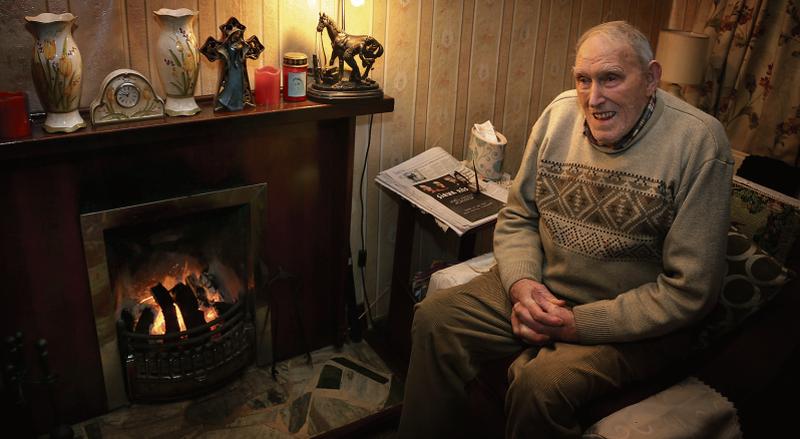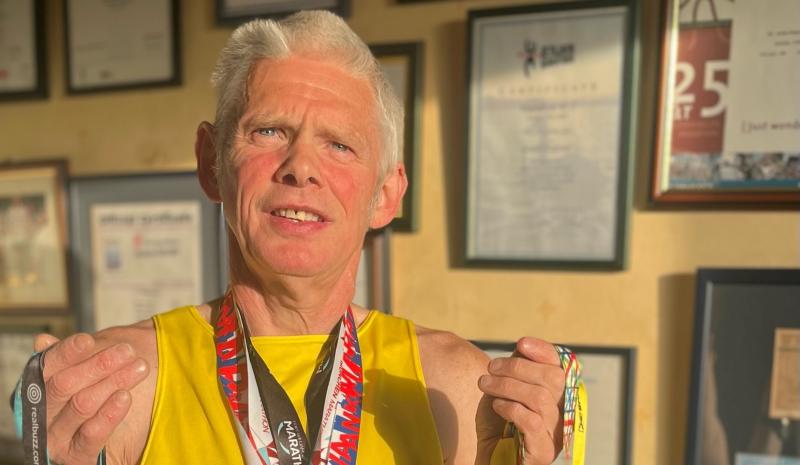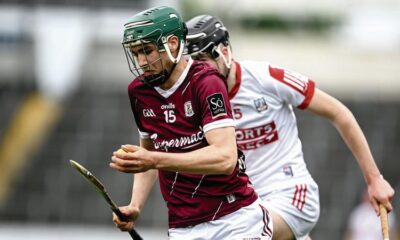Featured
Craftsman forged in heart of community

Lifestyle – Judy Murphy hears how 92-year-old Eamon Madden found his calling in the ancient trade of blacksmithing
They don’t make men like Eamon Madden any more. Athenry-born Eamon, who will celebrate his 92nd birthday on March 17, retired just four years ago, having worked as a blacksmith since the age of 14. The fifth generation of his family in the business he finally closed the doors of his forge having been advised by his doctor that it wasn’t a good idea to be shoeing horses and bearing their considerable weight at the age of 86.
Blacksmithing was the trade Eamon entered when he was barely out of childhood, and it was one he loved, he says. The Maddens’ forge on the outskirts of Athenry was a community hub, “like a pub, but without the drink”, and for someone as sociable as Eamon, that sociability made work a pleasure.
“It was a career too, and a matter of creating something, something you could hold up,” he says of his work.
He’s a tall, strong man, even as his 92nd birthday approaches, and he’s completely engaged with the world around him. As he sits by the fire in his cosy sitting room on a miserable February evening, there’s a newspaper by his side, and straight away, he starts discussing the issues of the day.
“I love being alive,” he says simply.
Although he was born on the feast of St Patrick in 1924, Eamon wasn’t named after the national saint, as the name Patrick had already been given to an older brother.
That brother died as a young man, the result of an accident while he was working in England. Another brother, Johnny, who lived at home, also died young after a wound became infected. Today, such an infection would be treated with antibiotics, but in the 1930s these weren’t available.
Johnny, who was some 20 years older than Eamon, had run the family blacksmith’s and his death led to Eamon eventually entering the business which their grandfather had established in Athenry.
But his links with this craft goes back much further. “I’m claiming to be the fifth generation of Maddens to be a blacksmith,” says Eamon, explaining that the family had a forge in the townland of Bawnmore for many years. Eamon’s granduncle inherited that premises, while his grandfather moved to Athenry in the mid 1800s, where “he bought a place and built it up”.
Eamon’s father became the farmer of the family, his uncle followed the blacksmithing tradition.
Eamon was born in 1924 into a period of great political change – the Irish Free State had come into being less than two years previously, marking the end of English rule in 26 counties of Ireland. That been followed by a civil war between those who opposed the treaty with England and those who supported it.
But while there were changes in how Ireland was governed, life in rural Galway continued to be dictated by the seasons and by farming.
“Ireland was an agricultural society then,” says Eamon, “it’s an industrial one now.” Farmers needed horses to work the land, and they needed implements. And, so, the blacksmith was central to their lives. When Eamon’s older brother Johnny died, their father tried to continue the business while also working the farm, but it proved too much. Initially, he employed men to do the work, but then he leased the forge to a local blacksmith Pat Brody, who subsequently married Eamon’s sister.
Pat taught Eamon the trade and from his earliest days, this tall, powerful young man was a natural. The forge was a world of intense noise and heat, where skill and concentration were required to forge items made of iron – everything from ‘S hooks’ for cutting briars to horseshoes for the valued farm animals.
Learning to shoe a horse was something Eamon can still remember – the shoe had to be nailed onto the hoof at an angle, making sure that it didn’t hit the animal’s flesh. There was very little to distinguish between the dead hoof and the living flesh, so great care was required.
For more, read this week’s Connacht Tribune.
Connacht Tribune
West has lower cancer survival rates than rest

Significant state investment is required to address ‘shocking’ inequalities that leave cancer patients in the West at greater risk of succumbing to the disease.
A meeting of Regional Health Forum West heard that survival rates for breast, lung and colorectal cancers than the national average, and with the most deprived quintile of the population, the West’s residents faced poorer outcomes from a cancer diagnosis.
For breast cancer patients, the five-year survival rate was 80% in the West versus 85% nationally; for lung cancer patients it was 16.7% in the west against a 19.5% national survival rate; and in the West’s colorectal cancer patients, there was a 62.6% survival rate where the national average was 63.1%.
These startling statistics were provided in answer to a question from Ballinasloe-based Cllr Evelyn Parsons (Ind) who said it was yet another reminder that cancer treatment infrastructure in the West was in dire need of improvement.
“The situation is pretty stark. In the Western Regional Health Forum area, we have the highest incidence of deprivation and the highest health inequalities because of that – we have the highest incidences of cancer nationally because of that,” said Cllr Parsons, who is also a general practitioner.
In details provided by CEO of Saolta Health Care Group, which operates Galway’s hospitals, it was stated that a number of factors were impacting on patient outcomes.
Get the full story in this week’s Connacht Tribune, on sale in shops now, or you can download the digital edition from www.connachttribune.ie. You can also download our Connacht Tribune App from Apple’s App Store or get the Android Version from Google Play.
Connacht Tribune
Marathon Man plans to call a halt – but not before he hits 160 races

On the eve of completing his 150th marathon, an odyssey that has taken him across 53 countries, Loughrea’s Marathon Man has announced that he is planning to hang up his running shoes.
But not before Jarlath Fitzgerald completes another ten races, making it 160 marathons on the occasion of his 60th birthday.
“I want to draw the line in 2026. I turn 57 in October and when I reach 60 it’s the finishing line. The longer races are taking it out of me. I did 20 miles there two weeks ago and didn’t feel good. It’s getting harder,” he reveals.
“I’ve arthritis in both hips and there’s wear and tear in the knees.”
We speak as he is about to head out for a run before his shift in Supervalu Loughrea. Despite his physical complaints, he still clocks up 30 miles every second week and generally runs four days a week.
Jarlath receives injections to his left hip to keep the pain at bay while running on the road.
To give his joints a break, during the winter he runs cross country and often does a five-mile trek around Kylebrack Wood.
He is planning on running his 150th marathon in Cork on June 4, where a group of 20 made up of work colleagues, friends and running mates from Loughrea Athletics Club will join him.
Some are doing the 10k, others are doing the half marathon, but all will be there on the finishing line to cheer him on in the phenomenal achievement.
Get the full story in this week’s Connacht Tribune, on sale in shops now, or you can download the digital edition from www.connachttribune.ie. You can also download our Connacht Tribune App from Apple’s App Store or get the Android Version from Google Play.
CITY TRIBUNE
Galway ‘masterplan’ needed to tackle housing and transport crises

From the Galway City Tribune – An impassioned plea for a ‘masterplan’ that would guide Galway City into the future has been made in the Dáil. Galway West TD Catherine Connolly stated this week that there needed to be an all-inclusive approach with “vision and leadership” in order to build a sustainable city.
Deputy Connolly spoke at length at the crisis surrounding traffic and housing in Galway city and said that not all of the blame could be laid at the door of the local authority.
She said that her preference would be the provision of light rail as the main form of public transport, but that this would have to be driven by the government.
“I sat on the local council for 17 years and despaired at all of the solutions going down one road, metaphorically and literally. In 2005 we put Park & Ride into the development plan, but that has not been rolled out. A 2016 transport strategy was outdated at the time and still has not been updated.
“Due to the housing crisis in the city, a task force was set up in 2019. Not a single report or analysis has been published on the cause of the crisis,” added Deputy Connolly.
She then referred to a report from the Land Development Agency (LDA) that identified lands suitable for the provision of housing. But she said that two-thirds of these had significant problems and a large portion was in Merlin Park University Hospital which, she said, would never have housing built on it.
In response, Minister Simon Harris spoke of the continuing job investment in the city and also in higher education, which is his portfolio.
But turning his attention to traffic congestion, he accepted that there were “real issues” when it came to transport, mobility and accessibility around Galway.
“We share the view that we need a Park & Ride facility and I understand there are also Bus Connects plans.
“I also suggest that the City Council reflect on her comments. I am proud to be in a Government that is providing unparalleled levels of investment to local authorities and unparalleled opportunities for local authorities to draw down,” he said.
Then Minister Harris referred to the controversial Galway City Outer Ring Road which he said was “struck down by An Bord Pleanála”, despite a lot of energy having been put into that project.
However, Deputy Connolly picked up on this and pointed out that An Bord Pleanála did not say ‘No’ to the ring road.
“The High Court said ‘No’ to the ring road because An Bord Pleanála acknowledged it failed utterly to consider climate change and our climate change obligations.
“That tells us something about An Bord Pleanála and the management that submitted such a plan.”
In the end, Minister Harris agreed that there needed to be a masterplan for Galway City.
“I suggest it is for the local authority to come up with a vision and then work with the Government to try to fund and implement that.”












